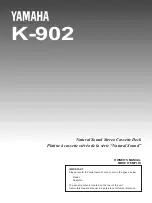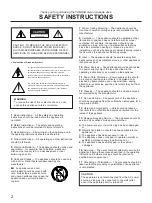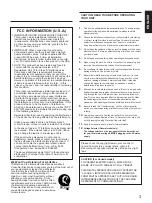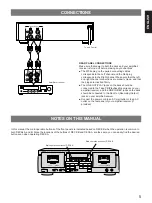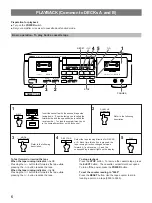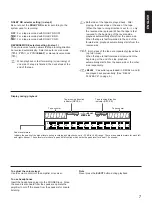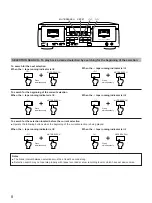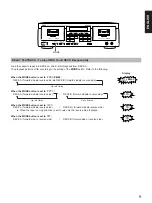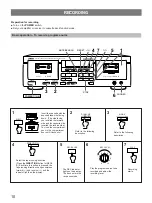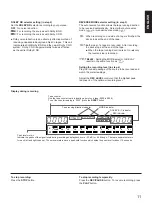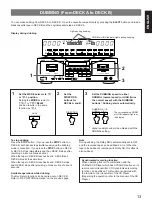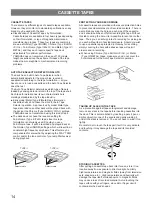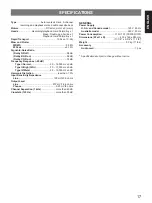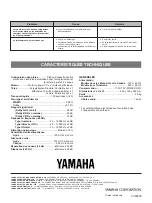
14
PROTECTING YOUR RECORDINGS
All cassette tapes are provided with erasure protection holes
to prevent accidental erasure of recorded contents. There is
a small tab covering the hole on each side of the cassette,
and it should be broken off after recording the tape. Without
this tab covering the hole, it is impossible to record onto that
tape. Thus, you can safely protect a recording for as long as
you wish without fear of accidental erasure. Should you wish
to use a cassette tape protected in this way for recording,
simply covering the hole with adhesive tape will permit
erasure and re-recording.
÷
When using Chrome (Type II/HIGH <CrO
2
>) or Metal
(Type IV/METAL) tapes, make sure you do not cover the
hole intended for the Auto Tape Selector operation.
TAKING UP SLACK IN THE TAPE
As a precaution against tape entanglement and damage,
remove any slack in the tape before inserting cassettes into
the deck. This is accomplished by inserting a pencil, pen or
similar object into one of the spools and gently winding it
until all the slack is removed. You do not have to wind it too
tightly.
Be careful not to touch the tape part itself. It is very delicate
and touching it may damage the tape and its recorded
contents.
STORING CASSETTES
After putting a cassette tape back into its case, store it in a
location away from exposure to direct sunlight, humidity,
high temperatures, and magnetic fields (away from television
sets, speakers, etc.). High temperatures and humidity will
damage the tape itself, while exposure to magnetic fields
may cause a loss of recorded material. Avoid touching the
tape surface with your fingers, since dirt or finger oil will
contaminate the deck’s heads.
CASSETTE TAPES
CASSETTE TAPES
There are many different types of cassette tapes available.
However, they all conform to standard specifications so any
brand may be used with the deck.
÷
Classification of Cassette Tapes by Formulation:
Cassette tapes are available in four basic types depending
on their formulation, or type of magnetic material and
manufacturing process. These four types are commonly
known as Normal (Type I/NORM), Chrome (Type II/HIGH
<CrO
2
>), Ferrichrome (Type III/FeCr), and Metal (Type IV/
METAL), and they each require specific tape deck
adjustments for optimum performance.
* YAMAHA does not recommend the use of 120 minute
length cassettes since the extreme thinness of the tape
makes them susceptible to mechanical and recording
problems.
AUTO TAPE SELECTOR DETECTION SLOTS
The deck has a built-in Auto Tape Selector which
automatically adjusts for the proper bias, level and
equalization according to the tape formulation — all you
have to do is to load a cassette and the Auto Tape Selector
does the rest.
The Auto Tape Selector determines which type of tape is
loaded by sensing detector slots in the top of the tape shell.
Each tape formulation has its own characteristic hole
markings standardized by the tape industry.
÷
Early model Metal (Type IV/Metal) tape formulation
cassette shells do not have the slots for Auto Tape
Selector operation. As a result, early model Metal type
tapes recorded on another deck will be played back with
the deck at the Chrome (Type II/HIGH <CrO
2
>) settings.
YAMAHA does not recommend using this kind of tape.
÷
The deck does not have the required setting for
Ferrichrome (Type III/FeCr) tape, since this tape
formulation is not widely used. Should you use a
Ferrichrome tape, it will be recorded and played back at
the Normal (Type I/NORM) settings, which will result in an
unnatural high frequency emphasis. This effect may be
compensated for somewhat by adjusting the PLAY TRIM
control and/or the tone controls of your amplifier/receiver
during playback.
Detector slots
Detector slots
TYPE II
TYPE IV

